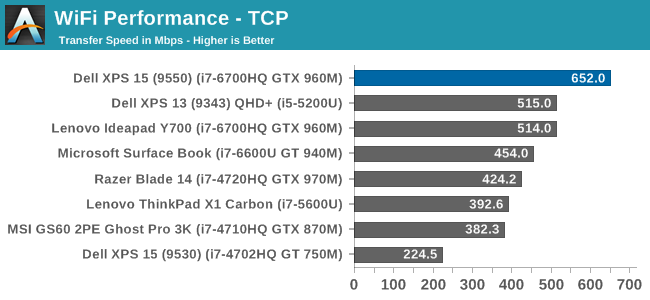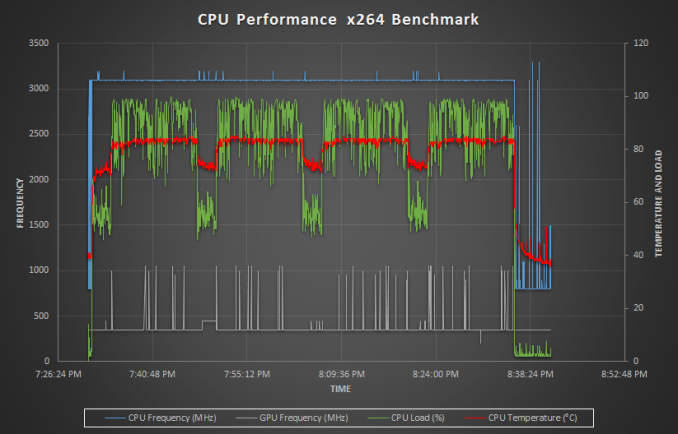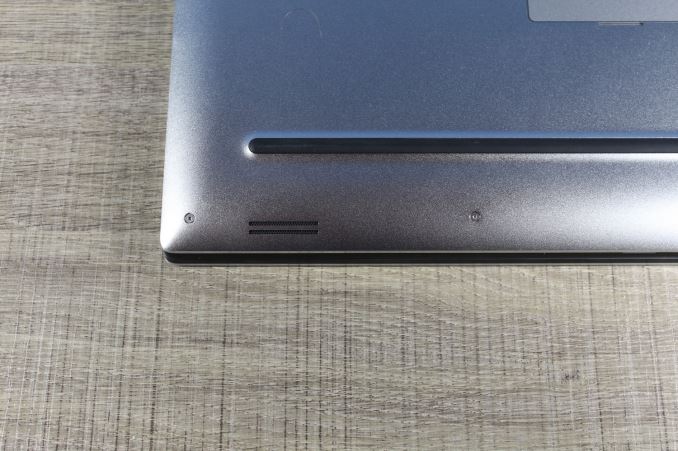The Dell XPS 15 9550 Review: Infinity Edge Lineup Expands
by Brett Howse on March 4, 2016 8:00 AM ESTWireless
The average laptop these days comes with a wireless card which can transmit and receive two spatial streams at once, and when it’s used with 802.11ac, that gives a maximum connection speed of 866 Mbps. The XPS 15 comes with a Broadcom wireless card which is 3x3:3, meaning it can work with a third spatial stream and has 50% more bandwidth available, which gives a maximum connection speed of 1.3 Gbps. Although on paper this is higher than Gigabit Ethernet, wireless rarely gets close to its maximum transmission speed whereas Gigabit Ethernet does. But assuming you have a router capable of 3x3 Wi-Fi, this solution should have a better shot of coming close to Gigabit Ethernet.

The XPS 15 sets a new AnandTech record on this test, beating out the Intel 8260 that only just jumped ahead on the last review. But to be honest I was expecting a bit better, if only because the 2x2 Broadcom solution could already hit 500 Mbps, so I was sort of expecting this to be over 700, but it’s still a good enough result that I didn’t feel like I needed to connect Ethernet when I was moving large files around on it, which isn’t something I can say about most laptops.
Thermals
When it comes to thermal considerations, shrinking the 15.6-inch form factor down, but still using higher performance (and therefore higher wattage) parts could be a concern. The CPU thermal design power is 45-Watts, and while NVIDIA doesn’t disclose the mobile GPU TDPs, it’s likely around 60-Watts or so. In most cases, GPU intensive workloads are not too hard on the CPU, and that’s true the other way as well. Laptop gaming, for instance, is very heavy on the GPU but generally not as taxing on the CPU, so in most scenarios Dell won’t have to remove the entire combined TDPs of both parts.
To test the CPU performance with a heavy and long duration workload, I logged the frequency and temperature of the CPU while running the x264 benchmark, which takes about an hour and runs the CPU near 100% load for the duration. As you can see, there was no thermal throttling at all in this workload, but the CPU certainly got warm, peaking around 84°C.
To test the GPU, I looped the Tomb Raider benchmark for about an hour, logging the GPU data every second. As with the CPU test, there was no thermal throttling of the GPU despite the heavy load and long duration. The GPU temperature never got over 79°C during this test.
Dell did a nice job on the cooling solution for the XPS 15. Despite the smaller chassis, it doesn’t appear to throttle under these workloads.
Noise
The other side of the cooling is noise. It’s an unfortunate side effect that in order to remove the heat, we have to rely on fans, and laptops with quad-core processors and GPUs are going to need fans. As with most laptops, the XPS 15 can disable its fans completely when lightly loaded, allowing quite operation, but once you do start to do some work, the fans slowly ramp up, starting around 36 dB(A) and going all the way up to 41.9 dB(A) on sustained light workloads. The XPS 15 can be silent, but once the fans kick in they are certainly audible.
Under heavy loads, the XPS 15 is, to put it bluntly, loud. I measured 52.7 dB(A) with the SPL meter 1” over the trackpad. This was after the GPU load test, where Tomb Raider was left running for over an hour. As a comparison, the Lenovo Y700 with the same CPU and GPU, and doing the same test, was closer to 44 dB(A) after the hour, and since decibels are logarithmic, that’s a big difference. This is the down side of a slim and light form factor: the fans are louder.
Audio
The XPS 15 has two speakers on the bottom of the laptop near the front. I measured 90 dB(A) from the speakers playing music, which makes this one of the loudest laptops I’ve seen. The sound quality is typical of a laptop, with not a lot of range and a lack of low end response.













152 Comments
View All Comments
Ryan Smith - Monday, March 7, 2016 - link
We've checked, and there's only a single drive (and not a RAID device) present in the Windows device manager.Soac - Wednesday, March 9, 2016 - link
I don`t think I have explained correctly. The Laptop came setup in RAID mode on the BIOS, from the forums I saw that it happened to everyone, and yes this is for the 1 single drive 512 samsung m.2. Hence why I said it didn`t make sense. However, if you change the BIOS setting to AHCI the read speeds go up to 1.7Gbps.-----------------------------------------------------------------------
CrystalDiskMark 5.0.3 x64 (C) 2007-2015 hiyohiyo
Crystal Dew World : http://crystalmark.info/
-----------------------------------------------------------------------
* MB/s = 1,000,000 bytes/s [SATA/600 = 600,000,000 bytes/s]
* KB = 1000 bytes, KiB = 1024 bytes
Sequential Read (Q= 32,T= 1) : 1723.554 MB/s
Sequential Write (Q= 32,T= 1) : 600.373 MB/s
Random Read 4KiB (Q= 32,T= 1) : 0.000 MB/s [ 0.0 IOPS]
Random Write 4KiB (Q= 32,T= 1) : 0.000 MB/s [ 0.0 IOPS]
Sequential Read (T= 1) : 0.000 MB/s
Sequential Write (T= 1) : 0.000 MB/s
Random Read 4KiB (Q= 1,T= 1) : 0.000 MB/s [ 0.0 IOPS]
Random Write 4KiB (Q= 1,T= 1) : 0.000 MB/s [ 0.0 IOPS]
Test : 1024 MiB [C: 21.6% (102.8/476.4 GiB)] (x5) [Interval=5 sec]
Date : 2016/03/09 23:13:32
OS : Windows 10 [10.0 Build 10586] (x64)
Funny enough, someone was saying that in RAID mode the drive felt faster... so it would be cool if you could test it.
medi03 - Sunday, March 6, 2016 - link
Would be interesting to see how it fares at gaming vs amd's carrizo notebooks.iks - Sunday, March 6, 2016 - link
While this is surely a great piece of tech, with a superb screen, capable hardware, and decent, cooling I still wonder, what is the target audience of this and other similar devices? Have the guys over at Dell and other companies actually tried to do productive work that involves a lot of typing on this so-called "keyboard"? Especially programming? Using impossible to hit buttons with no proper spacing, a short F row, minuscule arrows and no dedicated page up / page down / home / end. Sorry, but a keyboard like that is just dumb, and a torture to use.nerd1 - Sunday, March 6, 2016 - link
Say that to millions of mac users. Apple's DESKTOP keyboard is even worse than this.BPB - Monday, March 7, 2016 - link
I am a developer, and I use a company issued Dell at work (decent specs). The keyboard doesn't matter to me since I dock it at work. At home I leave it closed and plug a monitor/keyboard/mouse into it. So why should I care? I do occasionally use it by itself, but I don't mind since it's not very often. I guess what I'm saying is, how many developers use a notebook without plugging in peripherals?iks - Thursday, March 10, 2016 - link
Well, I'm learning to use Vim to overcome button limitations on the different keyboards I may get to work on in future. People work on 60% boards after all.As far as plugging peripherals in / out, aren't you afraid of the ports coming loose over time?
jasonelmore - Monday, March 7, 2016 - link
I wanted to point out that the laptop on this article has different materials depending on if you get the 1080p version vs the 4k version.The 1080p version has a lot more plastic vs the 4k one.
nerd1 - Monday, March 7, 2016 - link
1080p version lacks the glossy glass (which I hate), but it is identical elsewhere.rstuart - Monday, March 7, 2016 - link
I own one of these, but I run Linux. Typical Linux issues - if enable the NVidia card it doesn't boot, and it will be because NVidia hasn't released drivers for it yet. I'm mostly a command line user, so that doesn't worry me overly. The Intel drivers causing the kernel to crash 2 out of 3 boots on the other hand drove me nuts. The latest kernel has fixed that thank god, so it's rock solid now. I was surprised to read people running Windows are having the similar issues - here I was putting it down to Intel's poor support for Linux. It's more of a case of Intel not having good drivers, at all, on anything. Be patient, and be forgiving of Dell - it's Intel's problem, not Dell's.Apart from the display, it works extraordinarily well out of the box. As a Linux user, this is not something I'm used to. On the down side, there is not much in the box as Dell hasn't got their act together yet accessories - mostly because of the change to USB-C.
The one thing I do question myself about is going with the UHD display. It is gorgeous. But according to Dell the HD display roughly doubles the battery life, and in reality eye candy fade but not having to worry about charging during the day would have been appreciated for a long, long time.
One other feature not mentioned in the review is everything (battery, WiFi card, DIMM's, HDD/SSD, fans for cleaning) is accessible with the removal of 8 or so easy to find screws on the back. Unlike some other makes, Dell laptops have been getting better in this regard over the years.